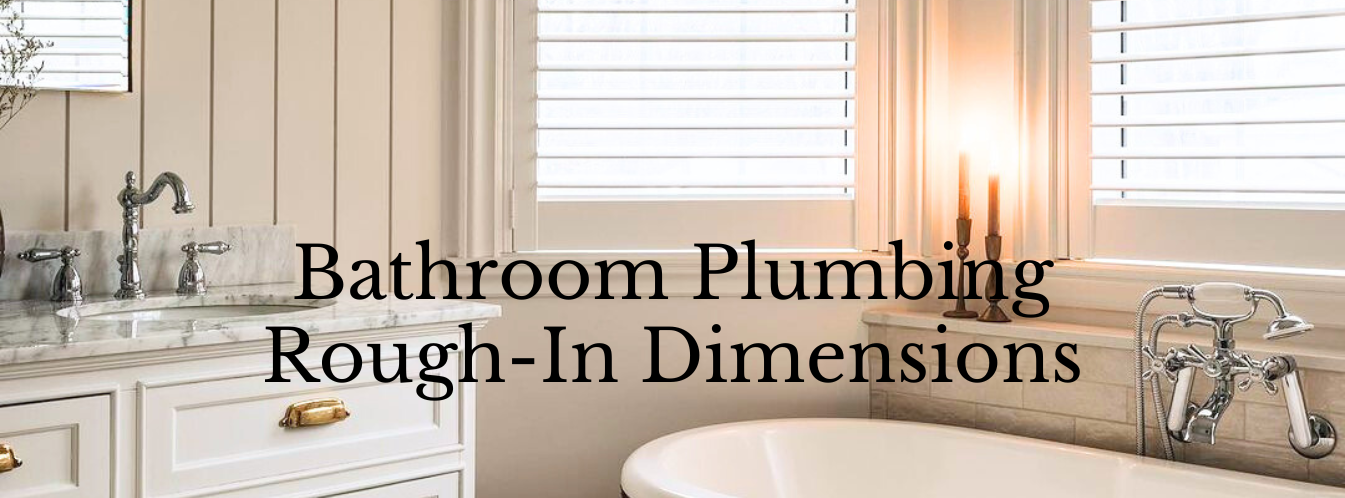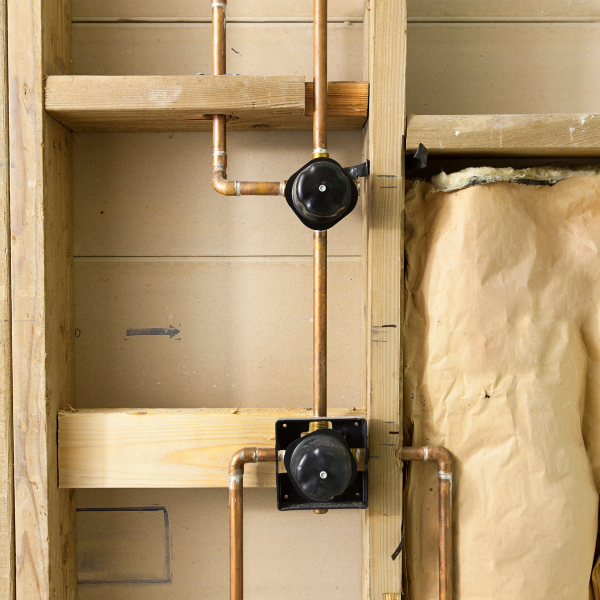Get PRO Pricing
Get [PRO] Pricing

The preliminary stages of setting up a bathroom's plumbing system, known as the rough-in phase, lay the groundwork for the installation of fixtures and ensure the seamless operation of water supply, drainage, and ventilation systems.
Proper bathroom plumbing is important for a multitude of reasons. A well-executed plumbing rough-in ensures that water flows smoothly into and out of fixtures, preventing potential issues such as leaks, clogs, or water damage. With a solid blueprint of how to arrange your bathroom rough-in plumbing, it will be a breeze to officially install your new fixtures like toilets, sinks, and bathtubs, ensuring they align perfectly with the intended design of the space. A meticulous approach to plumbing rough-in contributes to the overall efficiency and longevity of the plumbing system, reducing the likelihood of future repairs or modifications.

The bathroom plumbing rough-in marks the initial phase of plumbing installation, occurring during the construction or renovation of a bathroom space. This stage involves positioning pipes, drains, and ventilation systems in accordance with standard measurements and building codes. Understanding the intricacies of bathroom plumbing rough-in dimensions is essential for homeowners, contractors, and DIY enthusiasts alike, as it sets the foundation for a functional and reliable plumbing system in the long run.
Pipes

Pipes are the arteries of a plumbing system, carrying water to and from fixtures. During the rough-in phase, the correct sizing, positioning, and orientation of pipes are critical. This involves determining the distance between supply lines and ensuring proper slope for drainage pipes to prevent water stagnation.
Drains
Drains are designed to carry wastewater away from fixtures. The rough-in dimensions for drains involve positioning them at the correct distance from walls, adjacent fixtures, and the finished floor. Proper slope helps to facilitate effective drainage and prevent blockages.
Ventilation
Ventilation is a crucial yet often overlooked aspect of plumbing rough-in. Properly placed vents prevent airlock, allowing wastewater to flow smoothly. Rough-in dimensions for ventilation involve determining the correct placement and size of vent pipes to ensure the efficient release of sewer gasses and maintain the integrity of the plumbing system.
Understanding and adhering to standard measurements and guidelines is fundamental in achieving a successful plumbing rough-in. These standards are established to ensure uniformity and compliance with building codes. Key measurements include distances between fixtures, heights of pipes, and the diameter of pipes, all of which contribute to the seamless integration of plumbing systems within a bathroom space. Each fixture comes with specific rough-in requirements that must be considered during the plumbing rough-in phase.

Rough-In Distance for a Toilet from the Finished Wall
The rough-in distance from the finished wall to the center of the toilet drain is a critical dimension. This measurement determines the toilet's alignment with the plumbing system. Common rough-in distances include 10, 12, and 14 inches, with 12 inches being the standard for most toilets. Find the perfect toilet for your bathroom layout to create a well thought out space. *Note that if you are measuring from an unfinished wall, make sure to factor in the wall’s finished dimension when calculating the rough-in heights.

Rough-In Dimensions for Faucets and Drain
In addition to the sink basin, the rough-in dimensions for faucets and drains must be considered. Proper spacing and alignment ensure that faucets can be installed securely, and drains can function effectively. Adhering to standard measurements for faucet and drain rough-ins ensures compatibility with commonly available plumbing fixtures.
The placement of the actual sink should be 31 inches from the floor to the rim, but will vary depending on your specific application.

Drain placement assists in effective water drainage, preventing pooling and potential damage. Ventilation considerations are essential to prevent airlock and maintain optimal water flow. These dimensions are influenced by the specific design and type of bathtub or shower being installed.

The choice is ultimately yours when it comes to the height of a wall mount faucet, although there are some standards and best practices to consider. Knowing the best distance between the sink and a wall mount faucet will help avoid excessive splashing and back strain from overreaching.
The plumbing rough-in process, while important for establishing a robust infrastructure, is not without its challenges. Addressing these challenges effectively during the initial stages can prevent future complications and provide longevity for the bathroom plumbing system.

In renovation projects, existing structural elements and layouts may pose challenges when attempting to implement new plumbing rough-in dimensions. Altering the rough-in for renovations requires a thoughtful approach to adapt to pre-existing conditions. Creative solutions, such as rerouting pipes or utilizing compact fixtures, may be necessary to overcome space limitations while maintaining compliance with building codes. In these cases, it is recommended to consult a professional for assistance.
When upgrading a bathroom or replacing old plumbing systems, compatibility with existing structures and fixtures must be considered. Upgrading plumbing systems may involve replacing outdated pipes, adjusting rough-in dimensions to accommodate modern fixtures, and ensuring compliance with current building codes. The challenge lies in seamlessly integrating the new plumbing components with the existing infrastructure.
Addressing these common challenges requires a combination of research, adaptability, and adherence to industry standards. Consulting with a professional plumber or contractor during the planning stages can help identify potential issues and formulate effective solutions. Additionally, careful measurements, thorough inspections, and a comprehensive understanding of the existing conditions contribute to successful plumbing rough-ins in challenging scenarios.
Considering potential challenges and implementing strategic solutions during the plumbing rough-in phase is essential for the overall success of the bathroom construction or renovation project. By anticipating and addressing these issues proactively, homeowners and professionals can ensure a smooth and efficient plumbing system that meets both functional and regulatory requirements.

Building codes are a set of regulations and standards established by local authorities to ensure the safety, efficiency, and functionality of structures. Adhering to these codes is mandatory in the plumbing rough-in phase. Plumbing codes govern various aspects, including pipe sizing, fixture placement, ventilation requirements, and materials used. Familiarity with and strict adherence to these codes are helpful to avoid legal issues, ensure the well-being of occupants, and obtain necessary permits.
Non-compliance with building codes can lead to a range of serious consequences. Legal ramifications may include fines, delays in project completion, and the inability to obtain occupancy permits. More importantly, non-compliance can jeopardize the safety and well-being of the occupants, as improperly installed plumbing systems may pose health risks, structural damage, and increased maintenance issues over time.
Obtaining required permits for plumbing work is a fundamental step in the construction or renovation process. Permits are typically issued by local building authorities and ensure that the planned plumbing work meets safety and code requirements. Failing to secure proper permits can result in legal consequences and may hinder the ability to sell or insure the property in the future. It is essential to work with local building departments to obtain the required permits and undergo inspections to verify compliance with building codes.
The plumbing rough-in phase is a critical juncture where the importance of compliance with building codes is underscored. Plumbing codes are dynamic and may evolve over time, so staying informed about the latest regulations is essential. Working with experienced professionals who are knowledgeable about local codes ensures that the plumbing system not only meets current standards but also stands the test of time, contributing to the overall safety and longevity of the structure.

DIY Pros
DIY Cons
The professionals are our friends when it comes to safety and peace of mind. Consider handing off rough-in plumbing tasks during these cases:
Complex Projects: Complex plumbing systems, intricate designs, or extensive renovations may benefit from the expertise of a professional plumber. Their experience allows them to handle intricate details and navigate challenges effectively.
Building Code Compliance: Ensuring compliance with local building codes is crucial. Professional plumbers are well-versed in these codes, reducing the risk of non-compliance and associated consequences.
Time Sensitivity: If time is a critical factor, hiring a professional plumber can expedite the plumbing rough-in process. Professionals have the experience to work efficiently without compromising quality.
The decision between DIY and hiring a professional for a plumbing rough-in depends on factors such as project complexity, personal skills, and budget considerations. Striking a balance between cost savings and the need for professional expertise ensures a successful and compliant plumbing rough-in.
The plumbing rough-in phase is a critical aspect of any bathroom construction or renovation project, laying the foundation for a functional and efficient plumbing system. This article has explored the key components of understanding rough-in dimensions, including the definition and purpose, the significance of compliance with building codes, and the challenges faced during this phase.
Achieving precision in bathroom plumbing rough-in dimensions is vital for several reasons. Proper alignment and placement of pipes, drains, and ventilation systems contribute to the seamless integration of fixtures like toilets, sinks, and bathtubs. Precision minimizes the risk of issues such as leaks, improper drainage, and non-compliance with building codes, ensuring the long-term functionality of the plumbing system.
The success of a bathroom project hinges on the meticulous planning and execution of the plumbing rough-in. Whether opting for a DIY approach or seeking the expertise of a professional plumber, you must adhere to standard measurements, and address common challenges effectively.
A well-executed plumbing rough-in sets the stage for a bathroom that not only meets the practical needs of its occupants but also increases the value and comfort of the home. Remember, the success of the plumbing rough-in directly influences the success of the entire bathroom project, making it a pivotal phase in the creation of a space that stands the test of time.